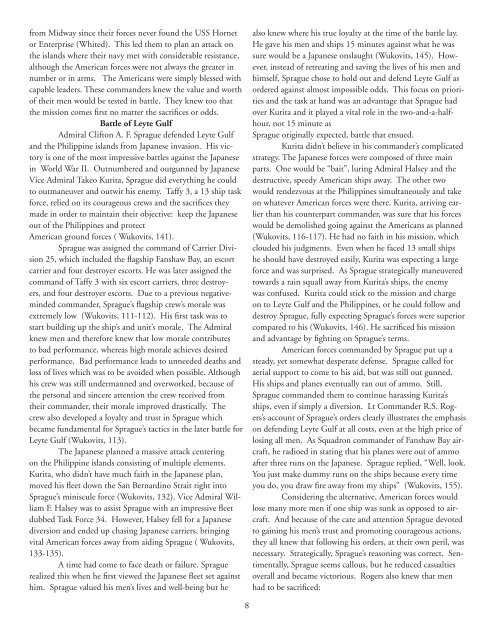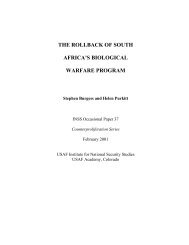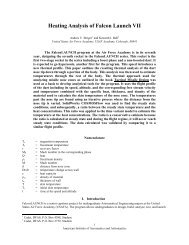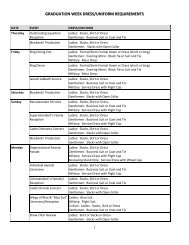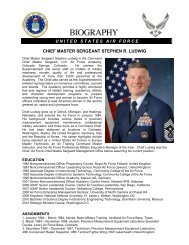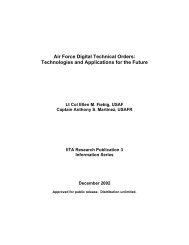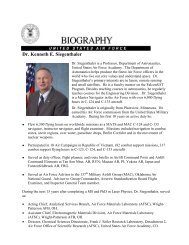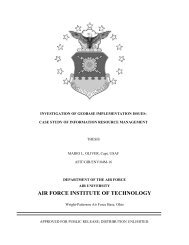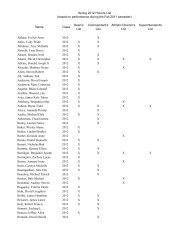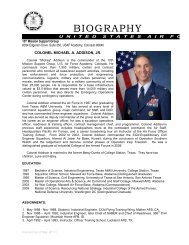Airman Scholar Sp05-1.indd - United States Air Force Academy
Airman Scholar Sp05-1.indd - United States Air Force Academy
Airman Scholar Sp05-1.indd - United States Air Force Academy
Create successful ePaper yourself
Turn your PDF publications into a flip-book with our unique Google optimized e-Paper software.
from Midway since their forces never found the USS Hornet<br />
or Enterprise (Whited). This led them to plan an attack on<br />
the islands where their navy met with considerable resistance,<br />
although the American forces were not always the greater in<br />
number or in arms. The Americans were simply blessed with<br />
capable leaders. These commanders knew the value and worth<br />
of their men would be tested in battle. They knew too that<br />
the mission comes first no matter the sacrifices or odds.<br />
Battle of Leyte Gulf<br />
Admiral Clifton A. F. Sprague defended Leyte Gulf<br />
and the Philippine islands from Japanese invasion. His victory<br />
is one of the most impressive battles against the Japanese<br />
in World War II. Outnumbered and outgunned by Japanese<br />
Vice Admiral Takeo Kurita, Sprague did everything he could<br />
to outmaneuver and outwit his enemy. Taffy 3, a 13 ship task<br />
force, relied on its courageous crews and the sacrifices they<br />
made in order to maintain their objective: keep the Japanese<br />
out of the Philippines and protect<br />
American ground forces ( Wukovits, 141).<br />
Sprague was assigned the command of Carrier Division<br />
25, which included the flagship Fanshaw Bay, an escort<br />
carrier and four destroyer escorts. He was later assigned the<br />
command of Taffy 3 with six escort carriers, three destroyers,<br />
and four destroyer escorts. Due to a previous negativeminded<br />
commander, Sprague’s flagship crew’s morale was<br />
extremely low (Wukovits, 111-112). His first task was to<br />
start building up the ship’s and unit’s morale. The Admiral<br />
knew men and therefore knew that low morale contributes<br />
to bad performance, whereas high morale achieves desired<br />
performance. Bad performance leads to unneeded deaths and<br />
loss of lives which was to be avoided when possible. Although<br />
his crew was still undermanned and overworked, because of<br />
the personal and sincere attention the crew received from<br />
their commander, their morale improved drastically. The<br />
crew also developed a loyalty and trust in Sprague which<br />
became fundamental for Sprague’s tactics in the later battle for<br />
Leyte Gulf (Wukovits, 113).<br />
The Japanese planned a massive attack centering<br />
on the Philippine islands consisting of multiple elements.<br />
Kurita, who didn’t have much faith in the Japanese plan,<br />
moved his fleet down the San Bernardino Strait right into<br />
Sprague’s miniscule force (Wukovits, 132). Vice Admiral William<br />
F. Halsey was to assist Sprague with an impressive fleet<br />
dubbed Task <strong>Force</strong> 34. However, Halsey fell for a Japanese<br />
diversion and ended up chasing Japanese carriers, bringing<br />
vital American forces away from aiding Sprague ( Wukovits,<br />
133-135).<br />
A time had come to face death or failure. Sprague<br />
realized this when he first viewed the Japanese fleet set against<br />
him. Sprague valued his men’s lives and well-being but he<br />
8<br />
also knew where his true loyalty at the time of the battle lay.<br />
He gave his men and ships 15 minutes against what he was<br />
sure would be a Japanese onslaught (Wukovits, 145). However,<br />
instead of retreating and saving the lives of his men and<br />
himself, Sprague chose to hold out and defend Leyte Gulf as<br />
ordered against almost impossible odds. This focus on priorities<br />
and the task at hand was an advantage that Sprague had<br />
over Kurita and it played a vital role in the two-and-a-halfhour,<br />
not 15 minute as<br />
Sprague originally expected, battle that ensued.<br />
Kurita didn’t believe in his commander’s complicated<br />
strategy. The Japanese forces were composed of three main<br />
parts. One would be “bait”, luring Admiral Halsey and the<br />
destructive, speedy American ships away. The other two<br />
would rendezvous at the Philippines simultaneously and take<br />
on whatever American forces were there. Kurita, arriving earlier<br />
than his counterpart commander, was sure that his forces<br />
would be demolished going against the Americans as planned<br />
(Wukovits, 116-117). He had no faith in his mission, which<br />
clouded his judgments. Even when he faced 13 small ships<br />
he should have destroyed easily, Kurita was expecting a large<br />
force and was surprised. As Sprague strategically maneuvered<br />
towards a rain squall away from Kurita’s ships, the enemy<br />
was confused. Kurita could stick to the mission and charge<br />
on to Leyte Gulf and the Philippines, or he could follow and<br />
destroy Sprague, fully expecting Sprague’s forces were superior<br />
compared to his (Wukovits, 146). He sacrificed his mission<br />
and advantage by fighting on Sprague’s terms.<br />
American forces commanded by Sprague put up a<br />
steady, yet somewhat desperate defense. Sprague called for<br />
aerial support to come to his aid, but was still out gunned.<br />
His ships and planes eventually ran out of ammo. Still,<br />
Sprague commanded them to continue harassing Kurita’s<br />
ships, even if simply a diversion. Lt Commander R.S. Rogers’s<br />
account of Sprague’s orders clearly illustrates the emphasis<br />
on defending Leyte Gulf at all costs, even at the high price of<br />
losing all men. As Squadron commander of Fanshaw Bay aircraft,<br />
he radioed in stating that his planes were out of ammo<br />
after three runs on the Japanese. Sprague replied, “Well, look.<br />
You just make dummy runs on the ships because every time<br />
you do, you draw fire away from my ships” (Wukovits, 155).<br />
Considering the alternative, American forces would<br />
lose many more men if one ship was sunk as opposed to aircraft.<br />
And because of the care and attention Sprague devoted<br />
to gaining his men’s trust and promoting courageous actions,<br />
they all knew that following his orders, at their own peril, was<br />
necessary. Strategically, Sprague’s reasoning was correct. Sentimentally,<br />
Sprague seems callous, but he reduced casualties<br />
overall and became victorious. Rogers also knew that men<br />
had to be sacrificed:


